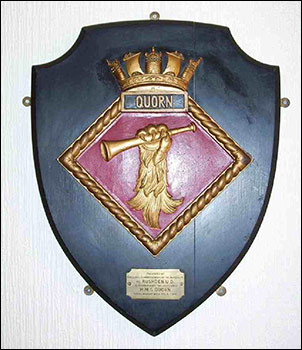|
|||
| Article by Steve Thornton 2007 |
|||
|
H.M.S. Quorn 1940-1944 |
|||
 |
|||
|
Throughout the Second World War there were regular national drives to raise money for the war effort. During one of these, Warship Week in February 1942, Rushden District (Rushden, Higham Ferrers and Raunds) ‘adopted’ H.M.S. Quorn, a Hunt Class destroyer. Setting themselves a very hard target of £250,000, they fell somewhat short, raising a still very creditable £200,231. (At this stage in the war the District were raising £50 per head compared with the national average of just over £20). Built between 1939 and 1940 by J. Samuel White and Co. at In 1944, under the command of Lt. Ivan Hall, she took part in the D-Day operations, initially escorting convoys across the channel, and later formed part of the naval force protecting the landing beaches. On the 3rd of August, however, she was on her way to Le Havre to carry out shore bombardment duties, but ran into a Germans naval force on their way to attack the beachhead, and was sunk by either a "Linsen" explosive motorboat or a German "Neger" manned torpedo. This is an eye witness account by Norman Ackroyd (a survivor) of the events of the night of 3rd August 1944: "The ship had been part of the beach head defence force for some nights before, on the night of August 3rd we sailed as normal just before dusk and went to all night action stations (I was part of No 3 gun’s crew on the quarterdeck) again as normal, this time however we were accompanied by an American radar ship and we were informed over the tannoy that at dawn we were going in close to Le Havre in order to bombard the e-boat pens. The American ship was to control the shelling. Just before Another survivor, Christopher Yorston, an AB at the time was up in the gunnery tower when Quorn was hit. “Within seconds I was in the water, looking up at the ship split in half,” he said. “If I had been in a cruiser, where the gun turret is completely sealed, I’d have been a goner. I grabbed hold of the first thing in the water, a lump of wood, and a converted trawler picked me up. It’s the luck of the draw.” (2) A total of four officers and 126 ratings were lost. (3) Among the dead was Lieutenant (E) John R. Dight, whose aunt, Mrs R.J. Butland, was a Rushden resident. “H.M.S. Quorn bore on her quarterdeck a commemorative plaque presented by the area. Her Ship’s Bible was a gift from Rushden and the small Bibles used by the men were given by the children of the district. Many other gifts, among them two harmoniums and a sketch of Rushden St Mary’s Church, were sent to the ship.” “Towards the end of last year the cadets of Rushden G.T.C. Company became responsible for the local liaison work, and at one of their gatherings during the winter they were visited by Mr. F. R. Ransome, the gunnery officer. A few months ago they received an illuminated address signed by every member of the ship’s company. Some of them had penfriends in the ship.” (4) The plaque given to Rushden Urban District on the Ship’s adoption, and a 50th anniversary memorial plaque, are currently displayed by the local branch of the Royal Naval Association in Rushden Working Men’s Club. References (1) http://uboat.net/allies/warships/ship/4628.html (2) http://www.navynews.co.uk/articles/2004/0408/0004082701.asp (3) http://en.wikipedia.org/wiki/HMS_Quorn (4) Rushden Echo And Argus, |
|||